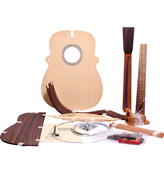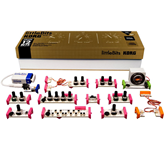What is STEM?
You’ve likely heard the acronym STEM in recent years, probably in discussions about education policy and curriculum choices. It stands for ‘Science, Technology, Engineering, Mathematics’ and it has been gaining a lot of attention in the business and technology sectors. The ever-growing appetite for high-tech gadgets, smart devices and self-driving cars, the need for better cyber-security, and the push for medical advances have led to a constant search for employees who have the necessary skills to support these areas. The importance of STEM education is becoming critical because companies cannot find enough talent to fill all of the jobs.
STEAM - what does the A represent?
Clearly, STEM programs are important. Within groups advocating for STEM education, there are proponents who think that STEM should actually be STEAM, with the “A” representing Arts (including music education). A quick Google search will turn up dozens (if not hundreds!) of articles supporting strict STEM adherence, advocating for STEAM inclusion, and many arguments in between. But the overarching theme is that today’s youth should be taught these in-demand skills earlier than ever - even starting in kindergarten.
The well-documented importance of music education
For those who advocate for the STEAM approach, it is helpful that the importance of music education has been well documented. The National Association for Music Education (NAfME), PBS Parents, VH1 Save the Music Foundation and many other organizations regularly publish articles and studies on the numerous benefits of listening to music and, even more favorable, learning to play a musical instrument. Cultivating better memory and language skills, increasing confidence and improving emotional and social development are just a few reasons that music advocates continue to push for music education programs in an era of education cuts. Now, with the increased focus on STEM education, many see these benefits of music education as fitting in perfectly with the STEM curriculum. One of the biggest reasons? Including arts and music education is seen as a pivotal way to close the gender and minority gaps in STEM fields, by incorporating elements early in curriculum that are inclusive and enjoyable for all students.
Where does music fit in with STEAM?
STEM/STEAM advocates highlight the interaction and interdependence of the elements. Science doesn’t operate independently from math, technology isn’t a separate aspect devoid of engineering, and so on. As a music educator, you may be thinking “Sure, STEAM sounds great, but I’m not a math teacher or a chemistry professor or an engineer.” But you understand that the skills learned from music education permeate many aspects of your students’ lives. You can incorporate elements of STEM into your music program (no matter what age group you instruct), and you could even work with the science and math educators at your school to incorporate music into their curriculum! Need some ideas?

Incorporate STEM into your music program
- For high school or college music students, incorporate design and engineering principles with the Martin Build Your Own Guitar Kit. Form groups of 3-4 students, provide each team with a kit, and watch them blossom into beginner luthiers!
- If you teach younger students, try the Make Your Own Cajon Kit from Nino Percussion. This kit is perfect for ages 5+ and will allow children to use basic building skills to create the cajon, arts skills to add visual design, and music skills to play the finished project.
Build music into a STEM curriculum
 Work with a sciences teacher to incorporate the Korg littleBits Synth Kit to help kids in grades three and older explore the science of sound and make music with this award-winning synthesizer.
Work with a sciences teacher to incorporate the Korg littleBits Synth Kit to help kids in grades three and older explore the science of sound and make music with this award-winning synthesizer.- Let older kids discover what it feels like to be an audio engineer using the Teenage Engineering OP-1 Portable Synthesizer Workstation. Help them understand the cool things audio engineers do, like using innovative technology to produce sound for computer games, electronic products, film, and music.
Next Steps
If you’re ready to turn STEM into STEAM at your school, or you want to approach your STEM educators about building music into their curriculum, you may be wondering where to find the budget. Woodwind & Brasswind is proud to work with educators to give you the best possible pricing. In addition, there are great music education grants available through many organizations, large and small. You can also create a project at DonorsChoose.org, which is an online charity dedicated to public school teachers in the US. STEAM curriculum encourages innovation, creativity, and industrious thinking - things that all educators have been doing for years.
If you need assistance with building or expanding your music program, call our Institutional Staff Advisors today at 800.346.4448 for educator discounts and product advice.
 Work with a sciences teacher to incorporate the
Work with a sciences teacher to incorporate the 
